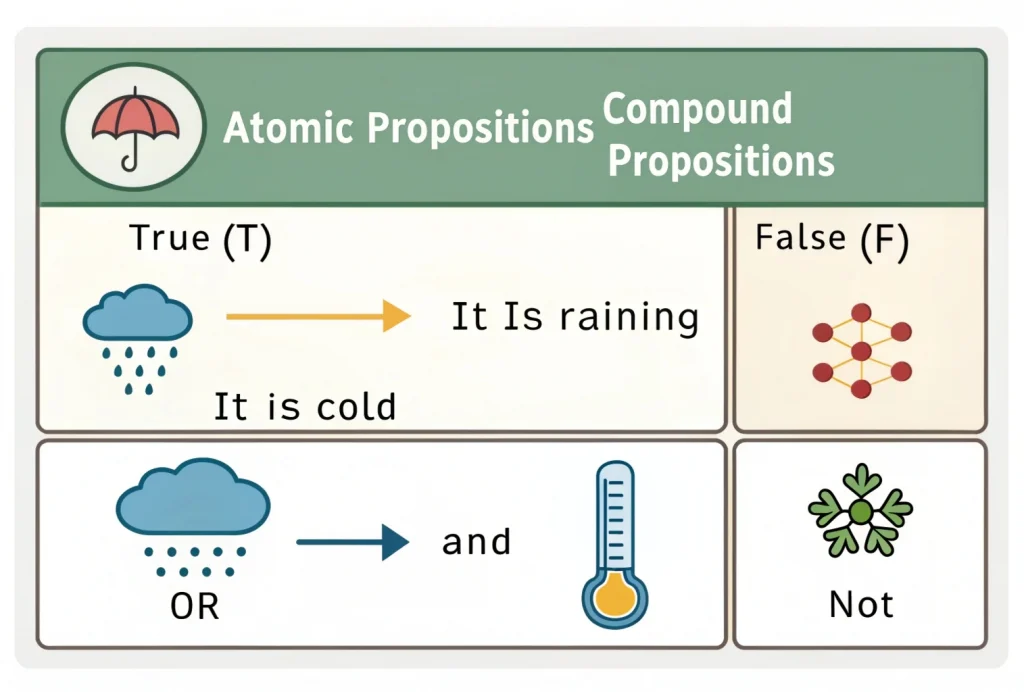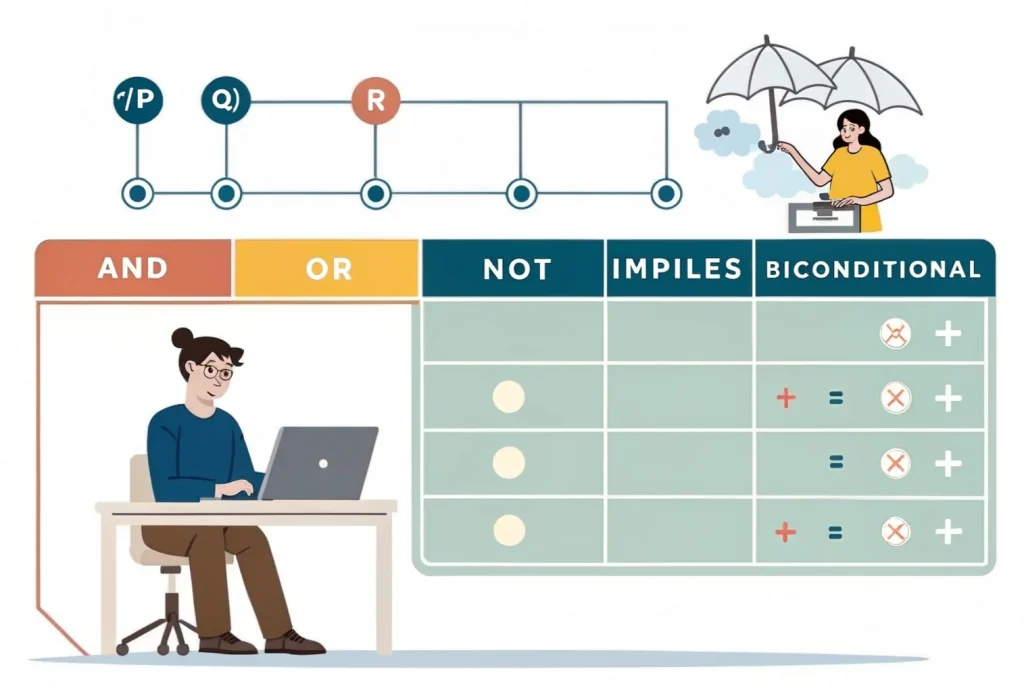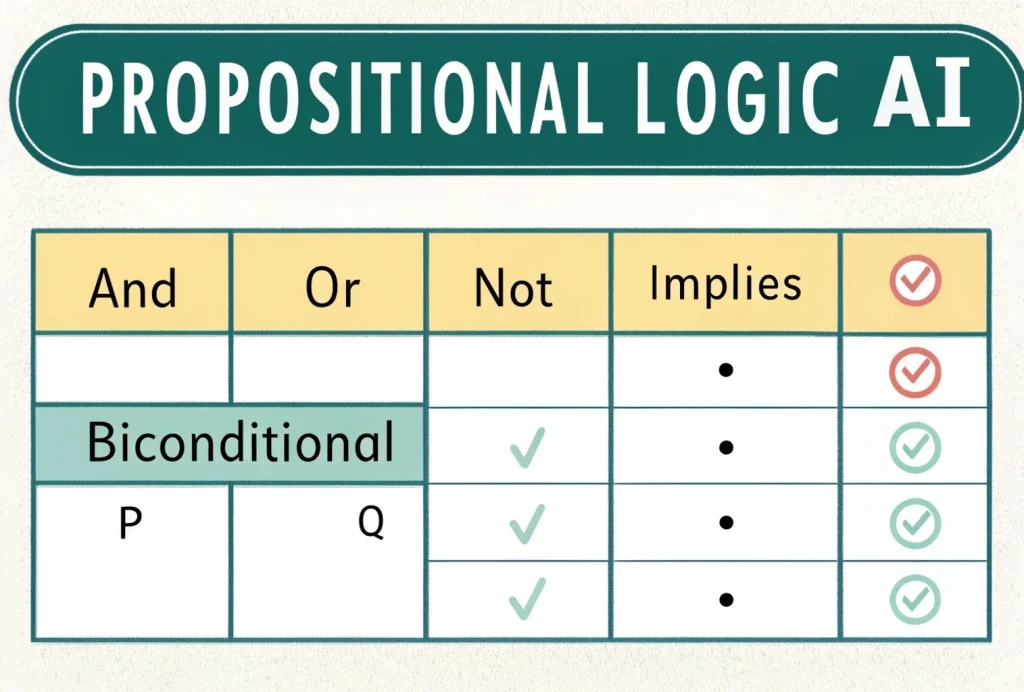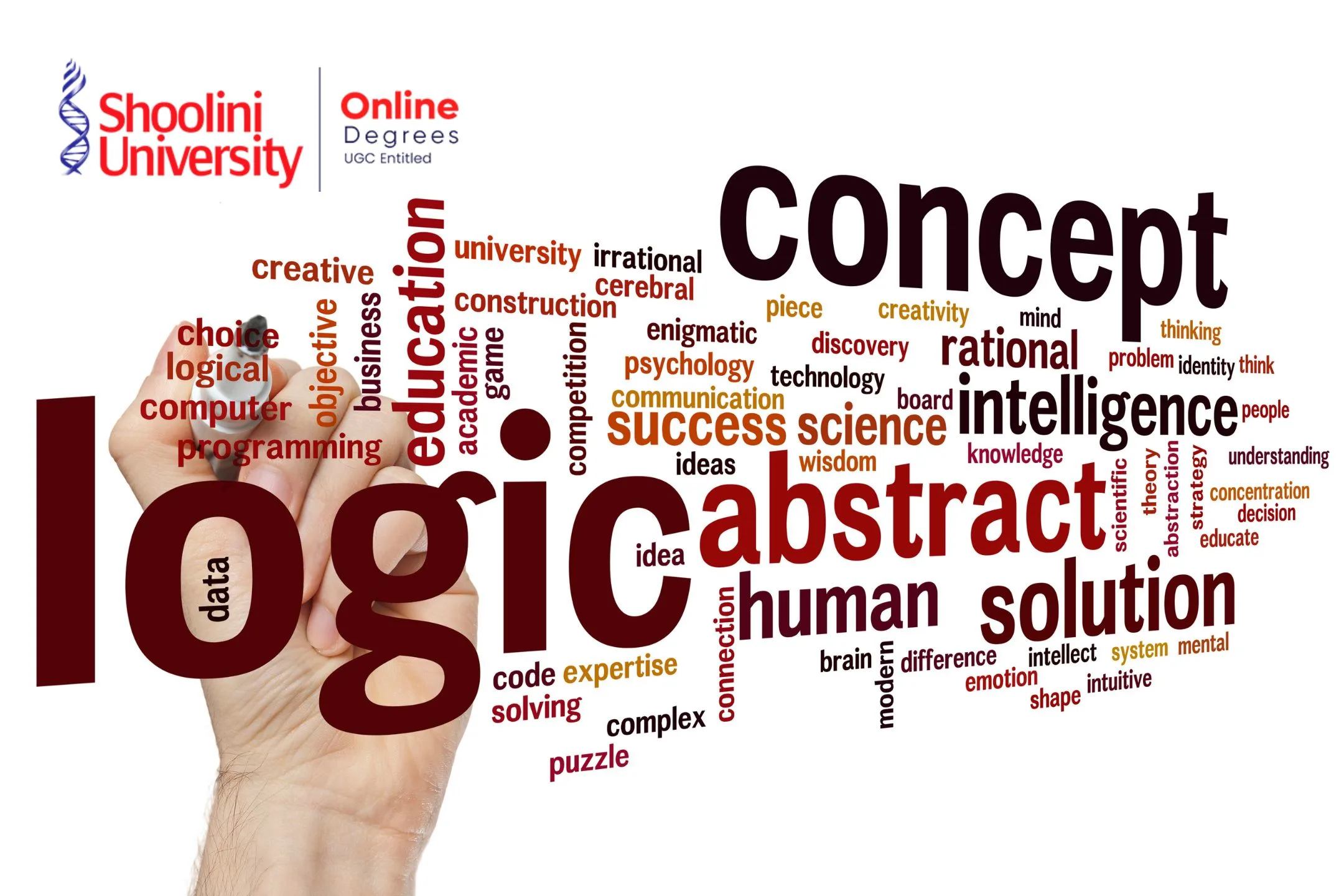Propositional Logic in ai is a basic form of logic that works with simple statements, called propositions, which can only be true or false. It’s like the “yes or no” way of thinking. In Artificial Intelligence (AI), propositional logic helps computers understand and work with facts and rules to make decisions. For example, a robot can use it to decide, “If it’s raining, then stay inside.” Even though it’s simple, this kind of logic is very important in AI because it teaches machines how to think logically, just like humans do. It is used in many areas like chatbots, game-playing, problem-solving, and smart assistants.
Basic Concepts

Propositions: Atomic and Compound
In propositional logic, a proposition is a simple sentence that can be either true or false, but not both. For example:
- “The sky is blue” is a proposition.
- “2 + 2 = 4” is also a proposition.
There are two types of propositions:
- Atomic propositions are the simplest kind. They don’t have any smaller parts. Example: “It is raining.”
- Compound propositions are made by combining two or more atomic propositions using words like and, or, or not.
Example: “It is raining and it is cold.”
Binary Truth Values: True/False
Every proposition can only have one of two truth values:
- True (T) if the statement is correct.
- False (F) if the statement is not correct.
For example:
- “Earth is round” → True
- “Cats can fly” → False
In AI, these truth values help machines understand the world using clear yes/no logic. This is important for making decisions, solving problems, or answering questions in a smart way.
Syntax and Semantics

Logical Connectives
To build more complex statements in propositional logic, we use special symbols called logical connectives. These connect simple (atomic) propositions to form larger ones (compound propositions). Here are the most common ones:
| Connective | Symbol | Meaning | Example | When is it True? |
|---|---|---|---|---|
| AND | ∧ | Both statements must be true | It is raining and it is cold. | Only when both are true |
| OR | ∨ | At least one statement must be true | It is raining or it is sunny. | When either or both are true |
| NOT | ¬ | Flips the truth value | It is not raining. | True if the original statement is false |
| IMPLIES | → | “If this, then that” | If it is raining, then the ground is wet. | False only if the first is true and second is false |
| BICONDITIONAL | ↔ | Both statements are either true or false | The light is on if and only if switch is up | True when both statements match (true/true or false/false) |
Formation Rules & Proposition Structure
The syntax of propositional logic is like grammar in a language—it tells us how to form valid logical sentences. A valid sentence must:
- Use propositions (like P, Q, R)
- Combine them using logical connectives
- Use parentheses to group parts clearly if needed
Example of a valid sentence:
(P ∧ Q) → ¬R
This means: “If P and Q are both true, then R is not true.”
The semantics explains the meaning of these sentences—whether they are true or false—based on the truth values of the propositions.
Explore our online programs to become future-ready
Transform your career with industry-aligned courses designed by experts.
4. Truth Tables & Logical Equivalences

Truth Tables for Each Connective
A truth table is a simple chart that shows all the possible outcomes (True or False) of a logical statement based on its parts. It helps us understand how each logical connective works.
Let’s look at a few examples:
| P | Q | P ∧ Q (AND) | P ∨ Q (OR) | ¬P (NOT P) | P → Q (IMPLIES) | P ↔ Q (BICONDITIONAL) |
|---|---|---|---|---|---|---|
| T | T | T | T | F | T | T |
| T | F | F | T | F | F | F |
| F | T | F | T | T | T | F |
| F | F | F | F | T | T | T |
This shows how different inputs lead to different outcomes. For example:
- P ∧ Q is only true if both are true.
- P → Q is false only when P is true but Q is false.
Equivalence Transformations
In logic, different-looking statements can sometimes mean the same thing. These are called logically equivalent statements. We use equivalence rules to rewrite them.
One common example is:
- P → Q is the same as ¬P ∨ Q
(If P implies Q, it’s the same as saying “either P is false or Q is true.”)
Other useful equivalences:
- ¬(P ∧ Q) ≡ ¬P ∨ ¬Q (De Morgan’s Law)
- ¬(P ∨ Q) ≡ ¬P ∧ ¬Q (Another De Morgan’s Law)
- P ↔ Q ≡ (P → Q) ∧ (Q → P)
These transformations help AI systems simplify logic statements, build efficient reasoning models, and solve problems more quickly.
Inference & Reasoning
In Artificial Intelligence, inference is the process of using known facts to discover new facts. This is what helps machines “think” and make logical decisions. Reasoning is the act of drawing conclusions based on rules and known information.
Deductive Rules (Modus Ponens, Modus Tollens)
These are basic reasoning rules used to make logical conclusions. Think of them like tools that help AI figure out what must be true based on given facts.
- Modus Ponens (If… then… rule)
If we know:- “If it is raining, then the road is wet.” (P → Q)
- “It is raining.” (P)
Then we can conclude: - “The road is wet.” (Q)
- Modus Tollens (The reverse test)
If we know:- “If it is raining, then the road is wet.” (P → Q)
- “The road is not wet.” (¬Q)
Then we can conclude: - “It is not raining.” (¬P)
These rules help AI systems make smart decisions based on logical steps, just like humans do.
Propositional Theorem Proving
This is a way to prove that a certain conclusion follows from a set of known facts using logic. It’s used in AI to solve problems, answer questions, or plan actions.
Some common methods include:
- Resolution:
A rule of inference used for proving that something is true (or false) by showing that the opposite leads to a contradiction. It’s especially useful in computer programs that deal with logic. - CNF (Conjunctive Normal Form):
This is a standard way to write logical statements. It makes complex sentences easier for a computer to process. In CNF, statements are broken into parts connected by ANDs (∧) and ORs (∨). - Horn Clauses:
These are a special type of logical statement that’s easy for computers to work with. They are widely used in AI systems, especially in rule-based and logic programming (like in Prolog).
Using these methods, AI can solve puzzles, make decisions, and even prove or disprove whether something is logically correct. It’s like giving machines a brain that reasons step-by-step!
Knowledge Representation & Logical Agents
Knowledge Representation (KR) is how we store facts, rules, and information in a format that a computer can understand and use to make decisions. It’s like building a brain for AI — we need a way for it to “remember” and “reason” about what it knows.
Building Simple Knowledge Bases
A knowledge base is a collection of facts and rules about a particular topic or world. For example, if we’re creating a knowledge base about animals, we might store:
- Fact: A whale is a mammal.
- Rule: If something is a mammal, it gives birth to live young.
From this, the system can infer that whales give birth to live young, even if it wasn’t told directly.
Knowledge bases are often built using logic, such as propositional or first-order logic, to define relationships between different facts.
Logic-Based Reasoning Agents (e.g., Wumpus World)
A logical agent uses reasoning to figure things out and make decisions. It starts with some basic knowledge and uses inference rules to deduce new facts.
A famous example is the Wumpus World:
- It’s a grid-based game world with hidden dangers like pits and a creature called the Wumpus.
- The agent must safely navigate the world by sensing clues (like a breeze indicating a nearby pit) and using logic to deduce where it’s safe to move.
This teaches how agents can make smart decisions even with limited information.
Symbolic AI and Rule-Based Systems
Symbolic AI represents knowledge using symbols (like words or logic statements) and rules (like “if-then” statements). For example:
- If a person is a student, then they get a discount.
This type of AI was very popular in early AI systems and is still used in expert systems, like those used in medical diagnosis or legal advice.
While symbolic AI is not as flexible as modern machine learning, it’s transparent and explainable, meaning we can easily see why the AI made a certain decision.
Applications in AI
Artificial Intelligence is used in many real-world areas to solve problems, make decisions, and even interact with humans. Below are some important applications where logic and reasoning play a key role.
Expert Systems & Decision-Making
Expert systems are computer programs that try to act like a human expert in a specific field—such as medicine, law, or finance.
- They use a knowledge base of facts and rules (like “If a patient has a high fever and cough, then they may have the flu”).
- A reasoning engine then uses logic to apply these rules and draw conclusions.
These systems help in decision-making, especially when human experts are not available. For example, a medical expert system can help diagnose diseases or suggest treatments based on symptoms.
Natural Language Processing (NLP) & Game-Playing
Natural Language Processing (NLP) is how AI understands and works with human languages—like English or Hindi. Logic helps here by:
- Understanding sentence structure (grammar rules).
- Figuring out meaning (semantics) using logical relationships.
For example:
- “All cats are animals. Tom is a cat. → Therefore, Tom is an animal.”
In game-playing AI, like chess or tic-tac-toe, logical reasoning helps the system:
- Plan moves,
- Predict the opponent’s next steps, and
- Choose the best strategy.
Games are a great way to test AI’s ability to reason, plan, and react in complex situations.
Planning, Multi-Agent Systems & Tsetlin Machines
Planning in AI means deciding what actions to take and in what order to reach a goal. For example:
- A robot planning how to clean a room: first pick up toys, then vacuum, then mop.
Multi-agent systems involve multiple AI agents working together—or sometimes competing. Think of:
- Self-driving cars coordinating traffic at an intersection.
- Bots in a multiplayer video game cooperating to defeat enemies.
They use logic and communication rules to share knowledge and avoid conflicts.
Tsetlin Machines are a newer logic-based AI model. They use simple yes/no (true/false) decisions (like propositional logic) to learn patterns in data. What makes them special is:
- They’re lightweight and efficient,
- Easy to understand, and
- Useful for problems like image recognition or text classification.
Limitations & Extensions
While logic-based AI is powerful and useful, it’s not perfect. It has some limitations, especially when dealing with real-world situations. Over time, researchers have developed extensions to make logical systems more flexible and intelligent.
Expressiveness Issues, Scalability & Handling Uncertainty
- Limited Expressiveness
- Basic logic systems like propositional logic can only handle simple true/false statements.
- They cannot express relationships like “Sita is the mother of Riya” or “All humans have emotions.”
- This makes it hard to model complex or real-world knowledge.
- Basic logic systems like propositional logic can only handle simple true/false statements.
- Scalability Problems
- As we add more facts and rules, the system can get slower and harder to manage.
- For example, an expert system with thousands of rules can take a long time to make a decision.
- As we add more facts and rules, the system can get slower and harder to manage.
- Handling Uncertainty
- Classical logic assumes everything is either true or false, but real life isn’t always black and white.
- For example, “It might rain tomorrow” — we’re uncertain, and logic struggles with “maybe.”
- Logic doesn’t work well when data is missing, vague, or incomplete.
- Classical logic assumes everything is either true or false, but real life isn’t always black and white.
Moving to Predicate/First-Order Logic and Probabilistic/Fuzzy Logic
To overcome these issues, more advanced types of logic were introduced:
- Predicate Logic (First-Order Logic)
- More powerful than propositional logic.
- Can handle variables and relationships.
- Example:
- “All dogs are animals” → ∀x (Dog(x) → Animal(x))
- This allows the system to reason about groups of objects, not just simple facts.
- “All dogs are animals” → ∀x (Dog(x) → Animal(x))
- More powerful than propositional logic.
- Probabilistic Logic
- Combines logic with probability to handle uncertainty.
- It can say things like:
- “There is a 70% chance that the patient has the flu.”
- “There is a 70% chance that the patient has the flu.”
- Useful in areas like medical diagnosis, spam detection, and weather forecasting.
- Combines logic with probability to handle uncertainty.
- Fuzzy Logic
- Deals with vague or imprecise information.
- Instead of just true/false, it allows values like “somewhat true” or “very cold”.
- Great for real-world systems like:
- Air conditioners (“adjust temperature based on how hot it feels”)
- Air conditioners (“adjust temperature based on how hot it feels”)
- Deals with vague or imprecise information.
Washing machines (“use more water if clothes are very dirty”)
Conclusion
Logic is an important part of Artificial Intelligence (AI) because it helps machines think and make decisions like humans. Using logic, AI systems can understand facts, follow rules, and solve problems. Simple types of logic, like propositional and first-order logic, allow AI to work in areas like expert systems, language understanding, and games. These systems use logical thinking to choose the best actions and give smart answers.
However, basic logic has some limits. It doesn’t work well when there’s too much information or when things are uncertain or unclear. That’s why more advanced methods—like predicate logic, probabilistic logic, and fuzzy logic—were developed. These help AI handle real-world situations better. Learning about these logic systems helps us build smarter, more helpful AI tools for everyday use.


Leave a Reply